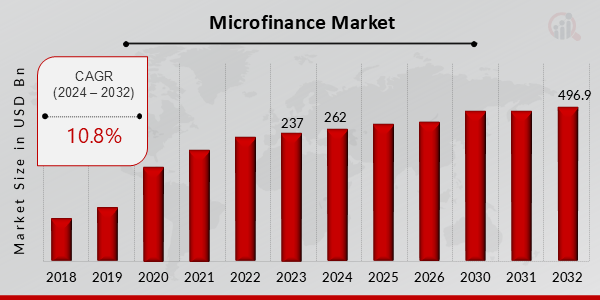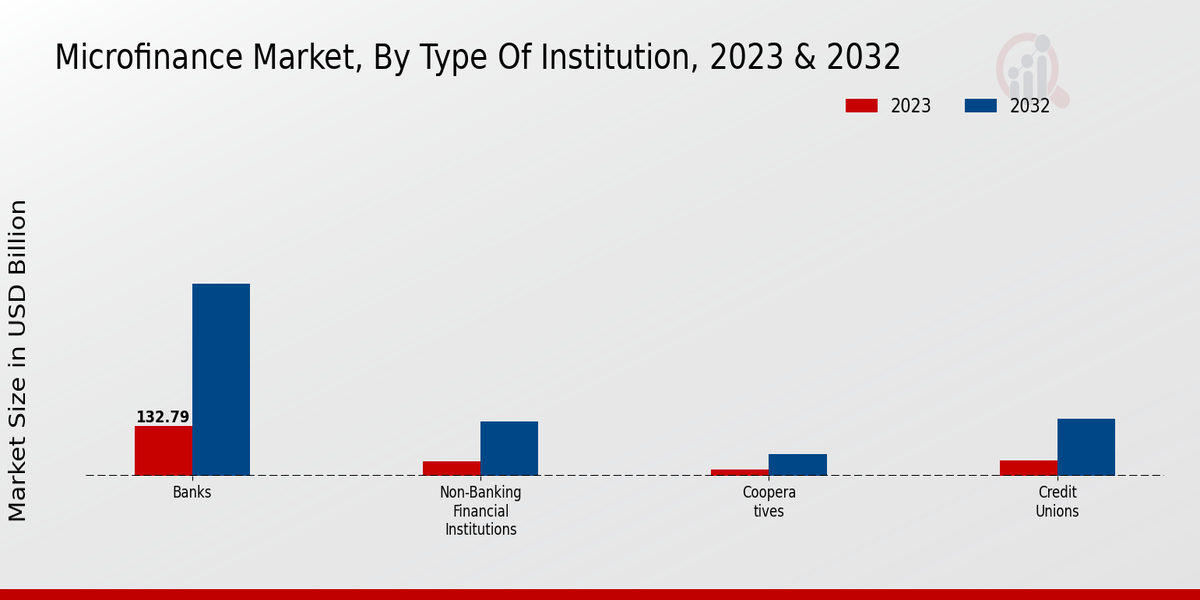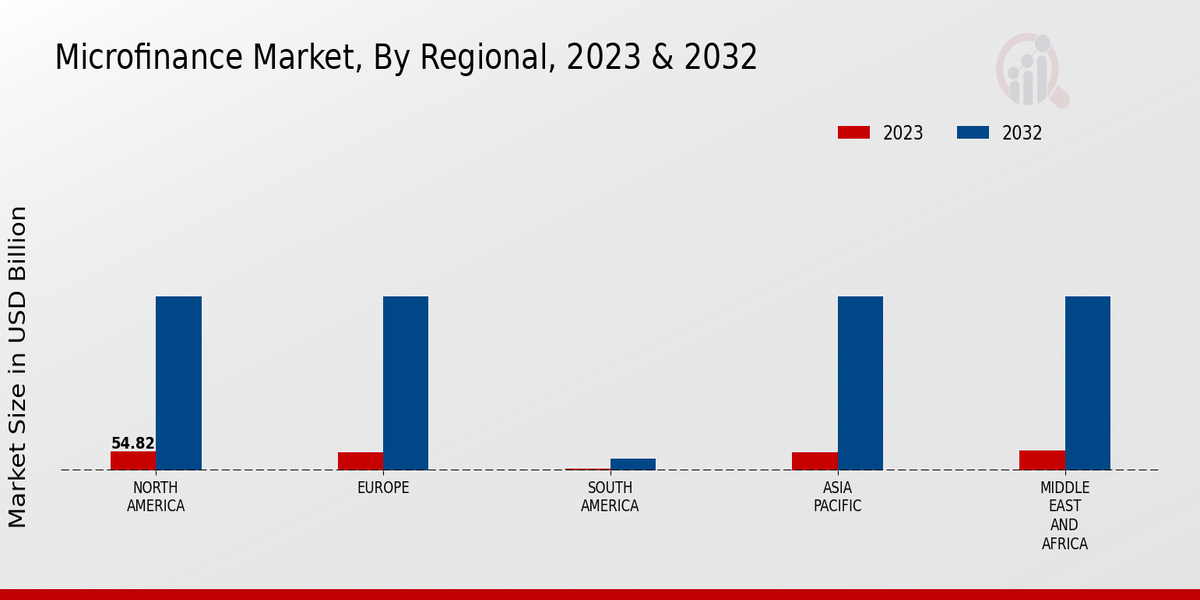Global Microfinance Market Overview:
Microfinance Market Size was estimated at 237 (USD Billion) in 2023. The Microfinance Market Industry is expected to grow from 262 (USD Billion) in 2024 to 496.9 (USD Billion) by 2032. The Microfinance Market CAGR (growth rate) is expected to be around 10.8% during the forecast period (2023 - 2032).
Key Microfinance Market Trends Highlighted
Growing financial inclusion, rising demand for accessible and affordable financial services, and the increasing adoption of digital technologies are driving the Microfinance Market. The proliferation of mobile banking and mobile money services in developing countries is expanding access to financial services for low-income populations. Governments and international organizations are actively promoting microfinance initiatives to address poverty and empower marginalized communities.
Moreover, the expansion of microinsurance products, which provide insurance coverage to low-income individuals and small businesses, is creating new growth opportunities in the microfinance market. The increasing use of alternative data, such as mobile phone data and social media activity, is enabling microfinance institutions to assess creditworthiness and provide tailored financial products to underserved populations.
Recent trends in the microfinance market include the emergence of fintech companies that are disrupting traditional microfinance models by offering digital-first services. The convergence of microfinance and other sectors, such as healthcare and agriculture, is creating new value propositions for microfinance institutions. The growing emphasis on environmental and social impact investing is also driving the development of sustainable microfinance practices and products.

Source: Primary Research, Secondary Research, MRFR Database and Analyst Review
Microfinance Market Drivers
Growing Demand for Financial Inclusion
Market Overview The microfinance market is driven by increasing demand for financial inclusion. In developing economies, a large part of the population does not have access to formal financial institutions. As a result, microfinance institutions have an excellent opportunity to provide access to affordable and convenient financial services. Offering individuals and small businesses access to the formal economy, microloans, savings accounts, and insurance lead to a reduction in poverty and social progress.As a result, the governments and such international financial institutions as the World Bank continue to focus on financial inclusion, thereby increasing the demand for microfinance and promoting market expansion. .
Technological Advancements and Digitalization
Technological innovations and digitalization have a significant impact on the Microfinance Market Industry. For example, the use of mobile banking, fintech platforms, and data analytics has increased the reach, efficiency, and delivery of microfinance services. Mobile banking empowers clients to access their funds, perform transactions, and receive financial services quickly and efficiently via their smartphones. The launch of cutting-edge fintech platforms has provided microfinance clients with viable and unique products and services.Data analytics have enabled microfinance organizations to assess credit scores, mitigate risk, and tailor their products and services to their clients’ needs. By combining these technologies, microfinance companies may increase their number of clients, decrease their operating expenditures, and improve their clients’ overall experience.
Supportive Government Policies and Regulations
Government policies and regulations play a major role in the Microfinance Market Industry. Regulations and policies that have been implemented by governments have helped the development and growth of microfinance institutions. Governments have enacted measures that support the promotion of financial inclusion, the provision of subsidies and incentives to microfinance institutions, the formation of regulatory bodies that oversee the regulation of the institutions and other measures.The implementation of these policies has broadened the successes of microfinance institutions and attracted investors to the market to facilitate the flow of capital. Governments appreciate the immense contribution of the microfinance to an improved economy and reduced poverty levels and will continue putting in place policies to support its growth.
Microfinance Market Segment Insights:
Microfinance Market Type of Institution Insights
Four types of institution may be distinguished in the Microfinance Market. Banks hold the largest market share in 2033. Revenues of banks formed over 50% of the Microfinance Market in 2033. Banks offer a wide spectrum of financial services to clients, including loans, savings accounts, and insurance. This type of institution has an extensive presence in urban and rural areas, and may also benefit from that banks may use their existing infrastructure for providing microfinance services. The second largest segment in the global market is NBFIs, which held the market share of 25% in 2033.NBFIs are financial institutions that specialize in service provision to clients, which may not have an access to conventional banks. This type of institution offers their clients a wider selection of products and services than banks, providing more flexibility than conventional banks. NBFIs are more localized type of finance providers than banks, offering their services in small areas. Finally, cooperatives are member-owned alternatives ad are the smallest of all three types of microfinance service providers. A credit union is a cooperative type of institution that offers its funds and services to its members.

Source: Primary Research, Secondary Research, MRFR Database and Analyst Review
Microfinance Market Product Type Insights
The Microfinance Market is segmented by product type, as also by the overall end-user. There are four main types of products: microloans, savings accounts, insurance, and money transfers. Besides, microloans are the most popular microfinance product, which is likely to occupy over 50% of the market in 2023. The second most shared product is the savings account, which will take over 30% of the market. The remaining share of the market is only for insurance and money transfers. At the same time, the microloans market will increase by 9.5% CAGR from 2023 to 2032, which likely to be 226.04 billion USD by 2032.The savings accounts market will grow by 9.2% CAGR from 2023 to 2032, which will be equal to 153.41 billion USD by 2032. The insurance microfinance market will increase by 9.8% from 2023 to 2032, that is 77.3 billion USD by 2032. The money transfer market will grow by 9.9% CAGR, that is likely to be equal to 51.1 billion USD by 2032.
Microfinance Market Loan Purpose Insights
The Microfinance Market segmentation by Loan Purpose includes Business Development, Education, Housing, and Agriculture. Among these segments, Business Development is expected to hold the largest market share in the coming years. The growth of this segment can be attributed to the increasing need for microfinance loans to support small businesses and entrepreneurs. Education is another significant segment of the Microfinance Market, as microfinance loans can help individuals and families access education and improve their skills. Housing is also a key segment, as microfinance loans can help low-income families access affordable housing.Agriculture is another important segment, as microfinance loans can help farmers and agricultural businesses access the financing they need to improve their productivity.
Microfinance Market Target Customer Insights
The target customer segment for the Microfinance Market consists of microentrepreneurs, low-income households, women, and youth. These groups represent a significant portion of the population in developing countries and have a strong need for access to financial services. Microentrepreneurs are individuals who own and operate small businesses with limited resources. They often lack access to traditional banking services and rely on microfinance institutions for loans, savings, and other financial products. Low-income households are families or individuals who live below the poverty line.They have limited access to financial services and often rely on informal sources of credit, which can be expensive and risky. Women and youth are also important target customers for the microfinance industry. In many developing countries, women have limited access to financial services due to cultural and legal barriers. Youth often lack the necessary collateral or credit history to qualify for traditional loans. The Microfinance Market is expected to grow significantly in the coming years, driven by the increasing demand for financial services from these target customer segments.
Microfinance Market Regional Insights
The regional segmentation of the Microfinance Market offers valuable insights into the industry's geographical distribution and growth patterns. North America holds a significant share of the market, driven by the presence of developed financial systems and a supportive regulatory environment. The market in Europe is characterized by a high penetration of microfinance services, particularly in countries like France, Germany, and the United Kingdom. APAC is anticipated to witness substantial growth over the forecast period due to the increasing demand for financial inclusion in emerging economies like India and China.South America exhibits promising growth potential, with countries like Brazil and Peru implementing initiatives to promote microfinance. The MEA region is expected to experience steady growth, primarily driven by the rising demand for financial services in underserved communities. These regional insights are crucial for businesses operating in the Microfinance Market as they enable them to tailor their strategies and capitalize on specific growth opportunities.

Source: Primary Research, Secondary Research, MRFR Database and Analyst Review
Microfinance Market Key Players And Competitive Insights:
Key participants in the Microfinance Market include within the industry. The major Microfinance Market industry players are involved in developing their geographical reach and introducing new products and services. In addition, the leading players in the Microfinance Market are making significant investments in technology to enhance their operational efficiency and reach a larger customer base. This competitive landscape is anticipated to drive Microfinance Market development as well as growth across the globe.
Acc. Accion is a prominent global player involved in the provision of microfinance services. The firm offers low-income populations in more than fifty nations across the globe with a wide range of financial products and services. Accion focuses on offering its consumers cheap and available financial products and services. The firm has a notable record of social performance. BRAC – is Bangladesh’s an international development and non-profit development organization. Bangladesh’s an international development and non-profit company is a significant player in the Microfinance Market. The company operates in over ten countries and provides its multiple financial products and services, banking facilities, and insurance offerings. The firm focuses on its revolutionary approach, which aims to tap the power of women for all its economic and microfinance purpose.
Key Companies in the Microfinance Market Include:
Microfinance Industry Developments
The Microfinance Market is expected to reach USD 513.4 billion by 2032, exhibiting a CAGR of 9.54% during the forecast period (2024-2032). The increasing demand for financial services in underserved communities, coupled with the rising adoption of digital technologies, is driving market growth. Government initiatives and partnerships between microfinance institutions and fintech companies are further contributing to market expansion. Recent news developments include the launch of new microfinance products and services, such as mobile banking and micro-insurance, to cater to the evolving needs of customers. Additionally, the expansion of microfinance services into rural and remote areas is creating new opportunities for growth.
Microfinance Market Segmentation Insights
Microfinance Market Type of Institution Outlook
Microfinance Market Product Type Outlook
-
Microloans
-
Savings Accounts
-
Insurance
-
Money Transfers
Microfinance Market Loan Purpose Outlook
-
Business Development
-
Education
-
Housing
-
Agriculture
Microfinance Market Target Customer Outlook
-
Microentrepreneurs
-
Low-Income Households
-
Women
-
Youth
Microfinance Market Regional Outlook
-
North America
-
Europe
-
South America
-
Asia Pacific
-
Middle East and Africa
| Report Attribute/Metric |
Details |
| Market Size 2023 |
237 (USD Billion) |
| Market Size 2024 |
262 (USD Billion) |
| Market Size 2032 |
496.9 (USD Billion) |
| Compound Annual Growth Rate (CAGR) |
10.8% (2024 - 2032) |
| Report Coverage |
Revenue Forecast, Competitive Landscape, Growth Factors, and Trends |
| Base Year |
2023 |
| Market Forecast Period |
2024 - 2032 |
| Historical Data |
2019 - 2023 |
| Market Forecast Units |
USD Billion |
| Key Companies Profiled |
Kiva ,MicroVest ,Accion International ,PRODEM ,SKS Microfinance ,Women's World Banking ,Opportunity International ,Plan International ,BRAC ,FINCA International |
| Segments Covered |
Type of Institution ,Product Type ,Loan Purpose ,Target Customer ,Regional |
| Key Market Opportunities |
Digitalization.Expansion into underserved areas.Partnerships with fintechs.Government initiatives.Growing demand for financial inclusion. |
| Key Market Dynamics |
Rising Microfinance Penetration.Expanding Government Initiatives.Increased Access to Technology.Growing Consumer Awareness.Digital Transformation. |
| Countries Covered |
North America, Europe, APAC, South America, MEA |
Frequently Asked Questions (FAQ) :
The Microfinance Market is anticipated to reach an overall valuation of 237 (USD Billion) in 2023.
The Microfinance Market is expected to exhibit a CAGR of 10.8% from 2023 to 2032.
The Microfinance Market is projected to reach an overall valuation of 496.9 (USD Billion) by 2032.
Factors contributing to the growth of the Microfinance Market include increasing financial inclusion efforts, rising demand for microfinance services in developing economies, and government initiatives to promote financial literacy.
Microfinance services are primarily utilized for income-generating activities such as small business loans, micro-insurance, and savings accounts, empowering individuals and communities to improve their economic well-being.
Prominent players in the Microfinance Market include Grameen Bank, BRAC, Kiva, Accion, and Opportunity International, among others.
The Microfinance Market is predominantly concentrated in developing regions, with significant presence in South Asia, Sub-Saharan Africa, and Southeast Asia, where access to traditional financial services is limited.
Challenges faced by the Microfinance Market include regulatory hurdles, high operational costs, and the need for tailored financial products to meet the diverse needs of microfinance clients.
Opportunities for the Microfinance Market lie in expanding financial inclusion through digital channels, leveraging technology to reduce costs, and collaborating with fintech companies to offer innovative financial solutions.
Trends shaping the Microfinance Market include the adoption of mobile banking, the integration of financial literacy programs, and the increasing focus on women's economic empowerment through microfinance services.

















